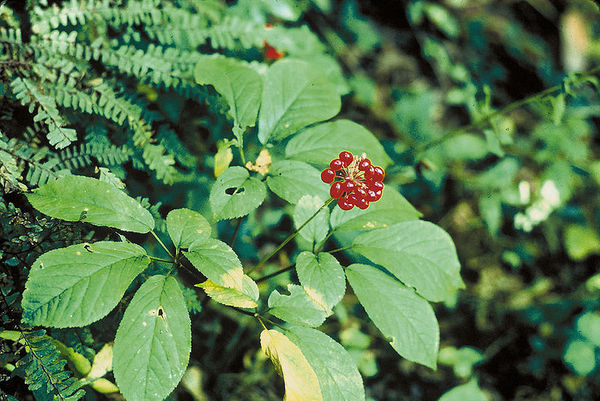
Common Name: American Ginseng | Scientific Name: Panax Qinquefolium

Family Name: Araliaceae
Introduction
American ginseng is the kissing cousin to Chinese ginseng and has many of the same properties of its Asian relative; it stimulates the body to renewed activity and function, strengthens all the major systems, and makes the body stronger in general. Its an herb to understand.
Resources
Notes from the Eclectic Physicians
Notes from the Eclectic Physicians
1874: Scudder:
Preparation – Prepare a tincture from the fresh or recent root, in the proportion of 3viij. to Alcohol 50degree Oj. Dose from gtts. v. to gtts. xx.
We have laughed at the Chinese for their use of Ginsent, which we have deemed inert, but I am pretty well satisfied that in this, as in some other things, they have the advantage of us. A limited use of the article has given me a very favourable opinion of its influence.
Its first use, and a very important one, is in the treatment of nervous dyspepsia. I have obtained more benefit from it in my own person, than from any other remedy, and I have employed it with others with equal advantage. It exerts a decidedly beneficial influence in exhaustion of the brain from over work, and it is probably that its influence is as much in this direction as upon the stomach.
It is one of those remedies, however, that produces no marked improvement at first, and must be continued for weeks to obtain its good effects.
1883: Scudder (tonic)
(The root of Panax Quinquefolia – U.S. )
Preparation – Tincture of Panax.
Dose – From one drop to half a drachm.
Therapeutic Action – Ginsent is feebly tonic, a pleasant stomachic and aromatic stimulant, a gentle nervine, slightly diaphoretic, and somewhat demulcent.
It promotes the appetite, facilitates digestion and invigorates the general system, and is considered beneficial in morbid states of the nervous system. Some are in the habit of employing it as a nervine and antispasmodic, either alone or associated with other agents balonging to that class, in cases of debility or irritability of the nervous system.
1895: Watkins: PANAX, SP MED:
Nervousness, headache, cardialgia, mental fatigue, dullness, inability to control the voluntary muscles, nausea and vomiting, vertigo. Ten drops to one half drachm, three times a day.
1898: Felter and Lloyd PANAX – GINSENG
Action, Medical Uses, and Dosage – A mild tonic and stimulant. Useful in loss of appetite, slight nervous debility, and weak stomach. Continued for some length of time, for its temporary administration gives but little benefit, it is a very important remedy in nervous dyspepsia, and in mental exhaustion from over-work. It gives fairly good results in nervous prostration, and in cerebral anemia. By some, it is considered useful in asthma, gravel, convulsions, paralysis, to invigorate the virile powers, etc. It gives fairly good results in atonic laryngitis, bronchitis, and some relief in phthisis, being a secondary remedy for these complaints. Dose, of the powder, from 10 to 60 grains; of the infusion, from 2 to 4 fluid ounces; specific panax, 5 to 60 drops.
Specific Indications and Uses – Nervous dyspepsia; mental and other forms of nervous exhaustion from overwork.
1898: Webster PANAX QUINQUEFOLIUM
This agent (ginseng) bears the indorsement of both Professor Scudder and Professor Goss, as a remedy for nervous dyspepsia.
Goss asserts that in dyspepsia from sedentary habits and from close mental application it is a valuable tonic, it probably acting through the pneumogastric nerve.
Form for Administration -The specific medicine.
Dose- From five to fifteen drops.
1901 : Harvey W Felter (Tonics) – PANAX – GINSENG
BOTANICAL ORIGIN – The root of Panax quinquefolium , Linne; Nat. Ord., Araliaceae . Found in the rich woods of North America as far south as Tennessee and Georgia .
This drug is a great favorite with the Chinese. It is a native of the United States and grows in rich shady woods. Its root is a mild stimulant and tonic. It is a good remedy in nervous dyspepsia, exercising a very beneficial influence upon the nervous system.
In cerebral anaemia its action is favorable, but its use must be prolonged to obtain its good effects. Use of the tincture from five drops to one drachm.
1911: Fyfe
Nervous debility, gastric derangement of nervous origin, loss of appetite. Panax quinquefolium is a mild tonic and stimulant.
1919: Ellingwood – PANAX, PANAX QUINQUEFOLIUM
Synonym – Ginseng.
Constituents – Panaquilon, gum, resin, starch, albumen.
Preparations – Specific Medicine Panax. Dose, from five to sixty minims.
Therapy – This agent is an important article of commerce in China , being a general domestic remedy and highly prized. It is a mild sedative and tonic to the nerve centers, improving their tone, if persisted in, and increasing the capillary circulation of the brain. It is given in cerebral anaemia, and if combined with other tonics is capable of doing some good. it is also prescribed in the failure of digestion incident to nervous prostration and general nerve irritation.
Disclaimer: The author makes no guarantees as to the the curative effect of any herb or tonic on this website, and no visitor should attempt to use any of the information herein provided as treatment for any illness, weakness, or disease without first consulting a physician or health care provider. Pregnant women should always consult first with a health care professional before taking any treatment.
